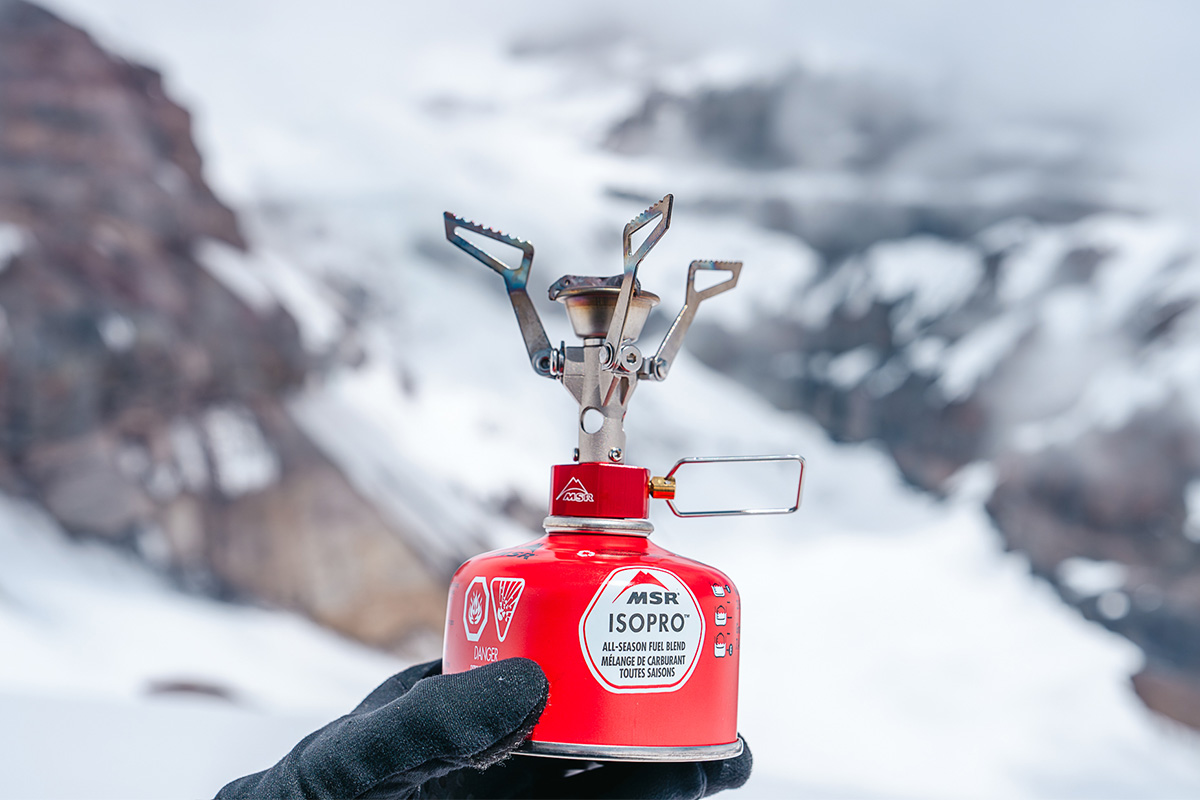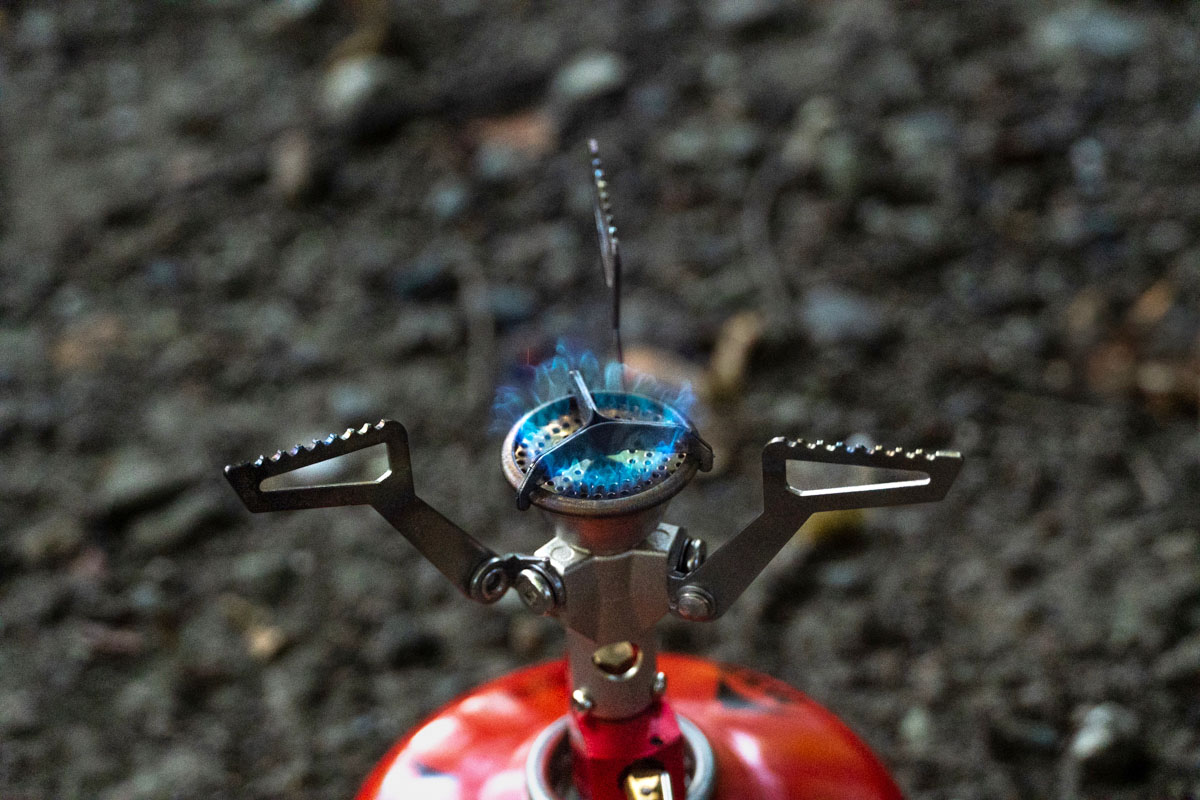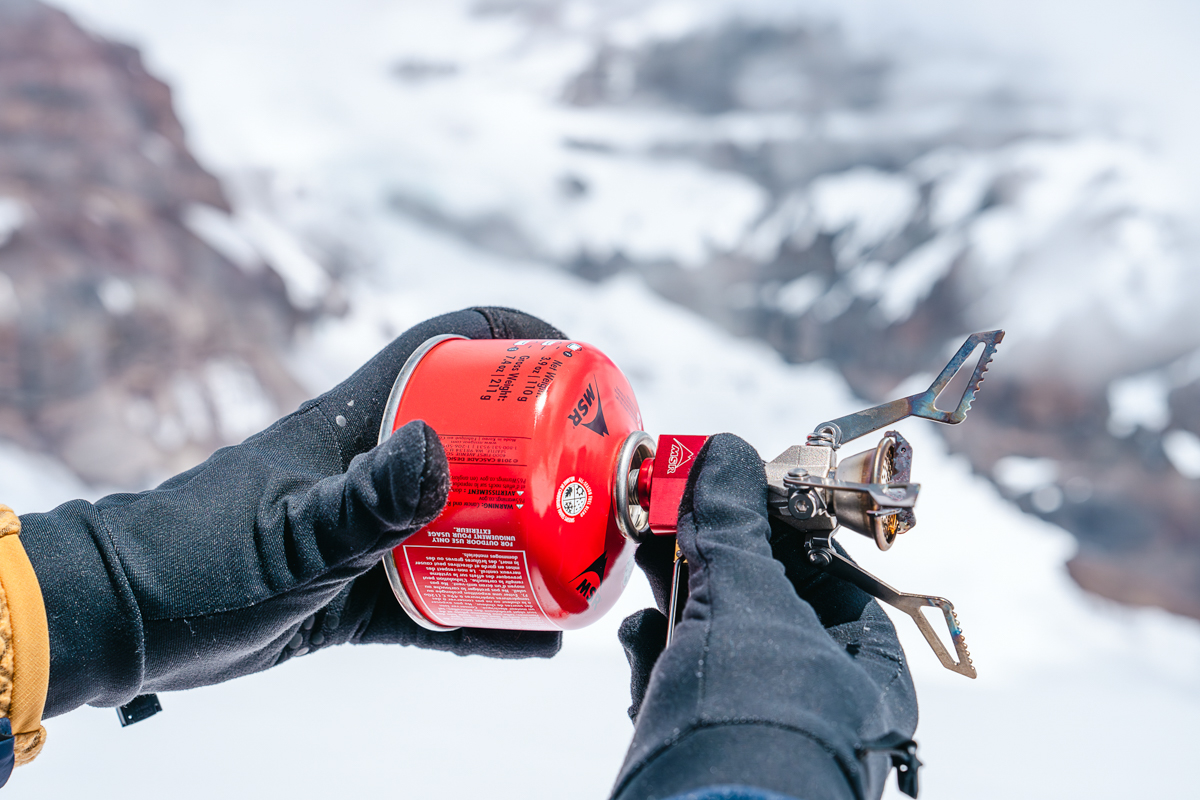

Price: $50
Weight: 2.6 oz.
Tested boil time: 4-4.5 minutes
What we like: An incredibly lightweight and intuitive design with an impressive burner.
What we don’t: Doesn't fare well in high winds or cold temperatures.
See the MSR PocketRocket 2 at REI See the MSR PocketRocket 2 at Backcountry
The MSR PocketRocket 2 has earned its place as one of the most iconic backpacking stoves on the market thanks to its proven performance and lightweight, compact design. While many members of our team have used and abused the PocketRocket throughout the years, we recently put it through an official test, taking it on a blustery ski touring trip in Mount Rainier National Park and a rainy backpacking trek in Wyoming's Wind River Range. While performance suffered in bit in the challenging conditions we faced, the PocketRocket is quick, efficient, and easy to use, making it a dependable choice for most backcountry adventures. Below are our thoughts on the PocketRocket 2. To see how it stacks up to the competition, check out our article on the best backpacking stoves.
The original MSR PocketRocket was a favorite among weight-conscious backpackers for its light and compact design, and the latest PocketRocket 2 is even more of a standout at a scant 2.6 ounces (0.4 oz. less than its predecessor). When folded down, the stove ends up being about the size of a granola bar and fits nicely inside the included plastic storage case, which is easy to stash in the brain of a pack. Alternatively, you can stow the stove inside a pot—in our case, it fit perfectly inside a 0.75-liter Soto pot with a 4-ounce IsoPro fuel canister, checking in at 6.7 ounces all in. MSR also sells an integrated cook kit that includes the stove plus a 0.75-liter aluminum pot, 16-ounce bowl, detachable pot handle, and mesh stuff sack for 9.8 ounces total.

MSR claims the PocketRocket 2 can boil a liter of water in 3.5 minutes. In our controlled tests at sea level, we found it took a bit longer: around 4 to 4.5 minutes with an aluminum pot. Even so, this is still on par with or faster than many direct competitors, including Soto's Windmaster, which has a claimed boil time of just over 4 minutes for 1 liter of water.

In the backcountry, however, weather had a significant impact on the PocketRocket 2's performance. The conditions on Mount Rainier's Paradise Glacier were both cold and windy with gusts reaching up to 30 miles per hour. This affected the flame's consistency and led to longer boil times and wasted fuel (more in "Weather Resistance" below). In a controlled environment, however, the PocketRocket 2 lived up to MSR's fuel efficiency claim, requiring just 1 ounce of fuel to boil 2 liters of water.
The PocketRocket 2's flame adjuster is user-friendly and extends far enough past the pot supports to safely adjust output without the risk of burning your fingers. It's also responsive without being too touchy, making it possible to maintain a low flame for simmering. It's true that stoves with built-in temperature regulators like the Jetboil MiniMo are more fine-tunable, but the PocketRocket 2 is surprisingly capable and versatile. It was a little harder to maintain consistent simmering in windy and cold conditions, but in favorable weather, the PocketRocket delivered a steady, low flame.

The PocketRocket 2's burner head is divided into three sections to help keep the flame burning in windy conditions. In theory, if one or two sections are extinguished, the remaining one(s) should reignite the flame. In light breezes, we found this system worked well, but it struggled in the gusty conditions we encountered on the Paradise Glacier. Despite several attempts to relight our stove, the wind repeatedly extinguished the flame, eventually forcing us to call it quits. To be fair, even the Jetboil Flash that we were testing alongside the PocketRocket had some issues, but there's no question that integrated canister systems with enclosed burners (like the Flash or MSR's purpose-built WindBurner) are more reliable in blustery weather due to the smaller gap between the flame and pot. Alternatively, you can pick up a windscreen to better protect the flame.

In rainy conditions, however, the PocketRocket 2 was unaffected. During our multi-day trip into the Wind River Range, we encountered frequent rainstorms, often boiling water for our dehydrated meals while huddled under trees or boulders. Despite the wet conditions, the PocketRocket 2 remained unfazed and consistently boiled water faster than the Jetboil Flash. A larger pot provided some cover for the flame, but even when exposed to the rain, the stove remained lit.

Cooking at high altitude can be tricky, and the effects on the MSR PocketRocket 2 were clear at 7,500 feet. As a canister stove, the PocketRocket 2 relies on high internal pressure to vaporize fuel, but colder temperatures at elevation slow this process. On the Paradise Glacier in freezing temperatures, boil times stretched to between 15 and 20 minutes for 1.5 liters of water (note: The wind also played a big role here). For cold weather-cooking, a remote canister system like MSR's WhisperLite Universal is the better option, allowing you to invert the canister or insulate it with a jacket. You can also buy a separate adapter to convert the PocketRocket 2 into a remote stove or use a stand to keep it elevated off the snow.
To combat the cold, we warmed the fuel canister with our hands, which helped significantly but was an uncomfortable task. Propping the stove on a ski also helped keep the canister out of the snow, improving its overall performance. And by midday, when the wind died down and the sun was intermittently shining, the PocketRocket 2 performed admirably, melting several liters of snow over the course of an hour.

Overall, the PocketRocket 2's minimalist design makes it very user-friendly. Setup is simple: Just unfold the arms and screw on the fuel canister. It lights easily with a lighter or match, offers precise flame control, and packs away pretty effortlessly once you're done cooking (although there's a slight learning curve to the folding process). Except in extreme cold or windy conditions, the PocketRocket 2 is intuitive and dependable enough that we're quick to reach for it on most backcountry trips.

That said, there are a few downsides to the simplistic design. Balancing a pot on the supports can be tricky, especially when the pot is full. While the arms are longer than the original PocketRocket's, maintaining stability still requires close attention. Additionally, some may miss the convenience of an auto-igniter or temperature regulator, both of which the PocketRocket 2 lacks. If these features are must-haves for you, the upgraded PocketRocket Deluxe is the better-equipped option with a built-in Piezo igniter and pressure regulator, though price jumps to $85.

The PocketRocket 2 has accompanied us on several adventures—from backpacking in Wyoming and skiing on Mount Rainier to weekend overnights, car camping by the river, and a bikepacking trip in Washington's Skagit Valley. Throughout, the stove has held up impressively well, and we've experienced only one issue: The screw at the base of the stem (just above the igniter) loosens over time. While this is an easy fix at home, it caused some wobbling when boiling water on the trail. A quick tightening with a pocket knife usually does the trick, but it's worth double checking before you head out. And aside from that minor issue, we have no concerns about long-term durability: The stove is well built with quality materials, and MSR backs it with a 3-year warranty should you encounter any significant problems.

We tested the flagship PocketRocket 2 for this review, and it's also sold in a Deluxe version. As we mentioned above, the PocketRocket Deluxe includes a push-start igniter and built-in regulator for better performance in the cold, although it's heavier (2.9 oz.) and pricier ($85). MSR also sells a couple cook kits that include an aluminum pot, plastic bowl, pot handle, and mesh storage bag. The kit that includes the PocketRocket 2 retails for $105 and checks in at 9.8 ounces all in, while the one that comes with the PocketRocket Deluxe is pricier at $140 and heavier at 13.1 ounces total.


| Stove | Price | Weight | Fuel Type | Auto Ignition | Pot | 1L Boil Time* |
|---|---|---|---|---|---|---|
| MSR PocketRocket 2 | $50 | 2.6 oz. | Canister | No | No | 3.5 min. |
| Soto WindMaster | $70 | 3.0 oz. | Canister | Yes | No | 4 min. |
| OliCamp Ion Micro | $50 | 1.5 oz. | Canister | No | No | 4.3 min. |
| Snow Peak LiteMax | $50 | 1.9 oz. | Canister | No | No | 4.4 min. |
| Jetboil Flash | $130 | 13.1 oz. | Canister | Yes | Yes (integrated) | 3.3 min. |
*Editor's note: This number represents claimed boil time for 1 liter of water. In real-world use and depending on conditions, we've found these times to be quite a bit higher.
The PocketRocket 2 is one of the most ubiquitous and proven backpacking stoves on the market, but there are plenty of other designs to consider. First is Soto’s WindMaster, which excels in one key area: wind resistance. With shorter supports that position the pot closer to the flame and a concave burner head, the WindMaster offers more flame protection, thus better reliability in blustery weather (although it’s still no match for integrated canister designs). It also features a built-in igniter and four pot supports, which we’ve found to be more stable than the PocketRocket’s three. However, the WindMaster comes at a steeper price ($70) and is slightly heavier at 3 ounces. Whether or not those penalties are worth the bump in windy-weather performance is up to you.

If keeping weight low is your biggest priority, it’s worth considering OliCamp's Ion Micro Titanium. At a remarkably low 1.5 ounces, it’s over an ounce lighter than the PocketRocket 2 while featuring a very similar overall design, including three pot supports and no auto ignition. However, the devil is in the details: While the OliCamp’s titanium build feels solid, the pot supports are noticeably looser, and the short adjuster handle makes fine-tuning the flame more difficult with a pot on top. And despite boasting more output (8,900 BTUs vs. the PocketRocket’s 8,200), the Ion Micro takes longer to boil a liter of water and is less fuel-efficient to boot. Unless you’re counting every gram, we think the PocketRocket 2 is the less compromised option for the price.
Snow Peak's LiteMax Titanium is another lighter-weight alternative to the PocketRocket 2, checking in at just 1.9 ounces. Compared to the OliCamp Ion covered above, the LiteMax has an easier-to-access flame adjuster and more stable pot supports, but it still makes some compromises in the name of weight savings. Most notable are boiling time (listed at 4.4 minutes for 1L of water) and fuel efficiency, although the Snow Peak's burner is more powerful than the MSR’s at 11,200 BTUs. We still think the PocketRocket is the better overall design, but the LiteMax isn’t far off.

Last but not least, it’s worth comparing the PocketRocket 2 to an integrated canister system like Jetboil’s popular Flash. The Flash's all-in-one design locks the pot directly onto the burner, reducing the gap between the flame and the pot for a considerable boost in wind resistance. In gusty conditions on the Paradise Glacier, both stoves had difficulty staying lit, but the Flash held its flame longer and boiled water faster. The Jetboil also comes with a few added conveniences: a 1-liter aluminum pot, a plastic stand for supporting a fuel canister, a push-button igniter, and a color-changing heat indicator that lets you know when your water is boiling. The biggest downsides are weight, bulk, and cost, with the Flash clocking in at a hefty 13.1 ounces and relatively steep $130. In the end, the two stoves have very different strong suits: We’d opt for the lighter and cheaper PocketRocket in favorable conditions, while the Flash is the more weather-worthy design and nice for casual backpackers who don’t mind shuttling the extra weight.